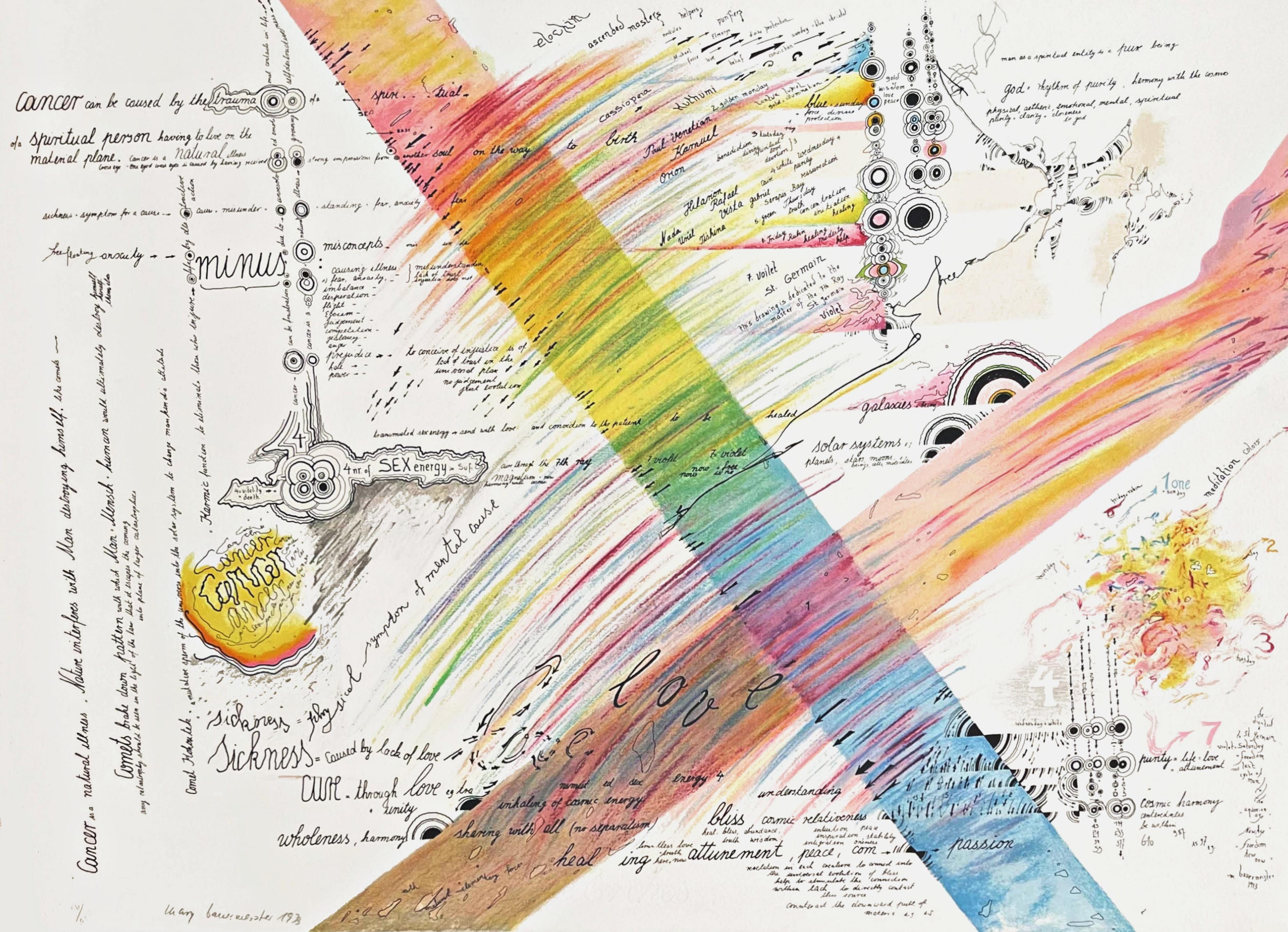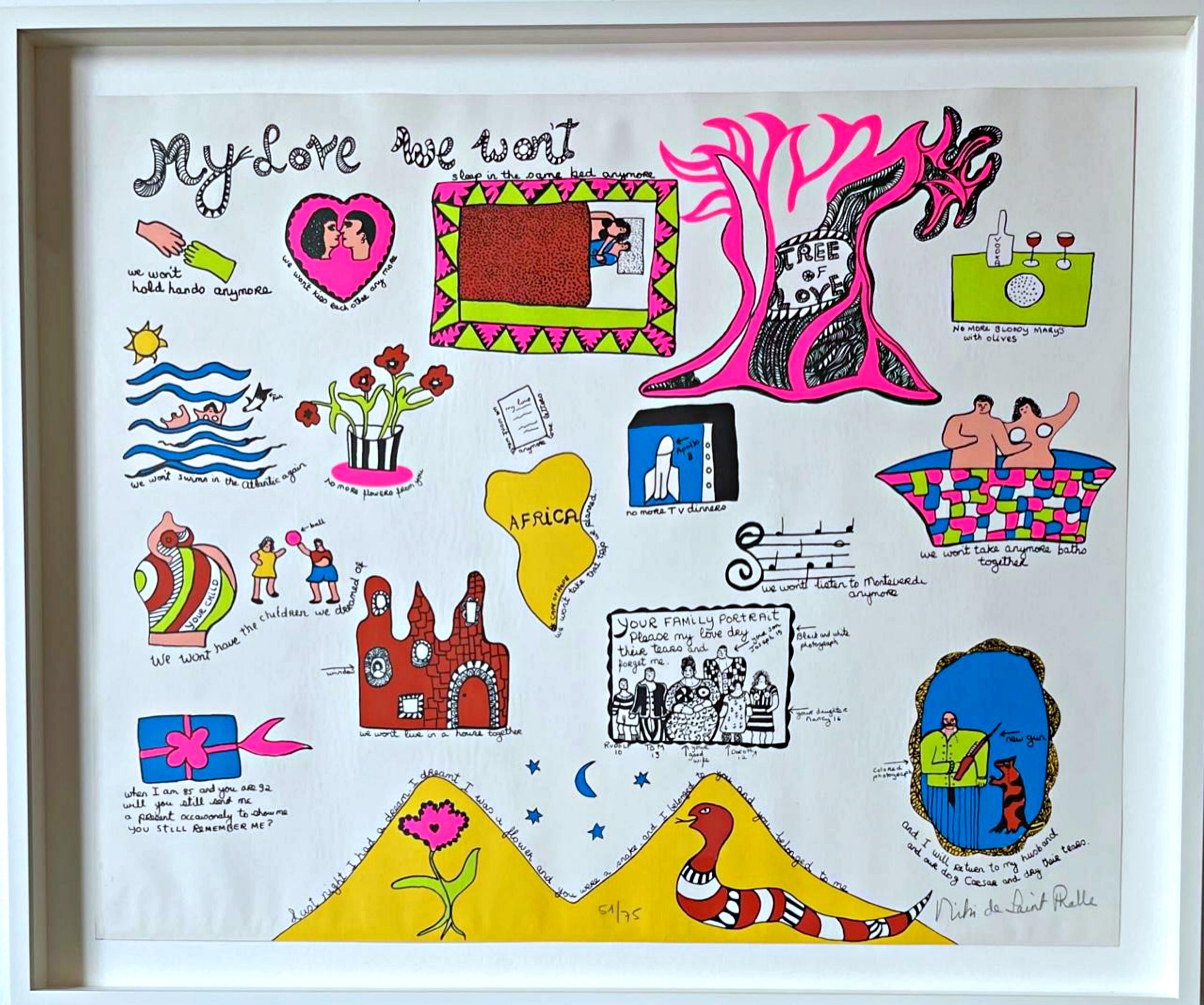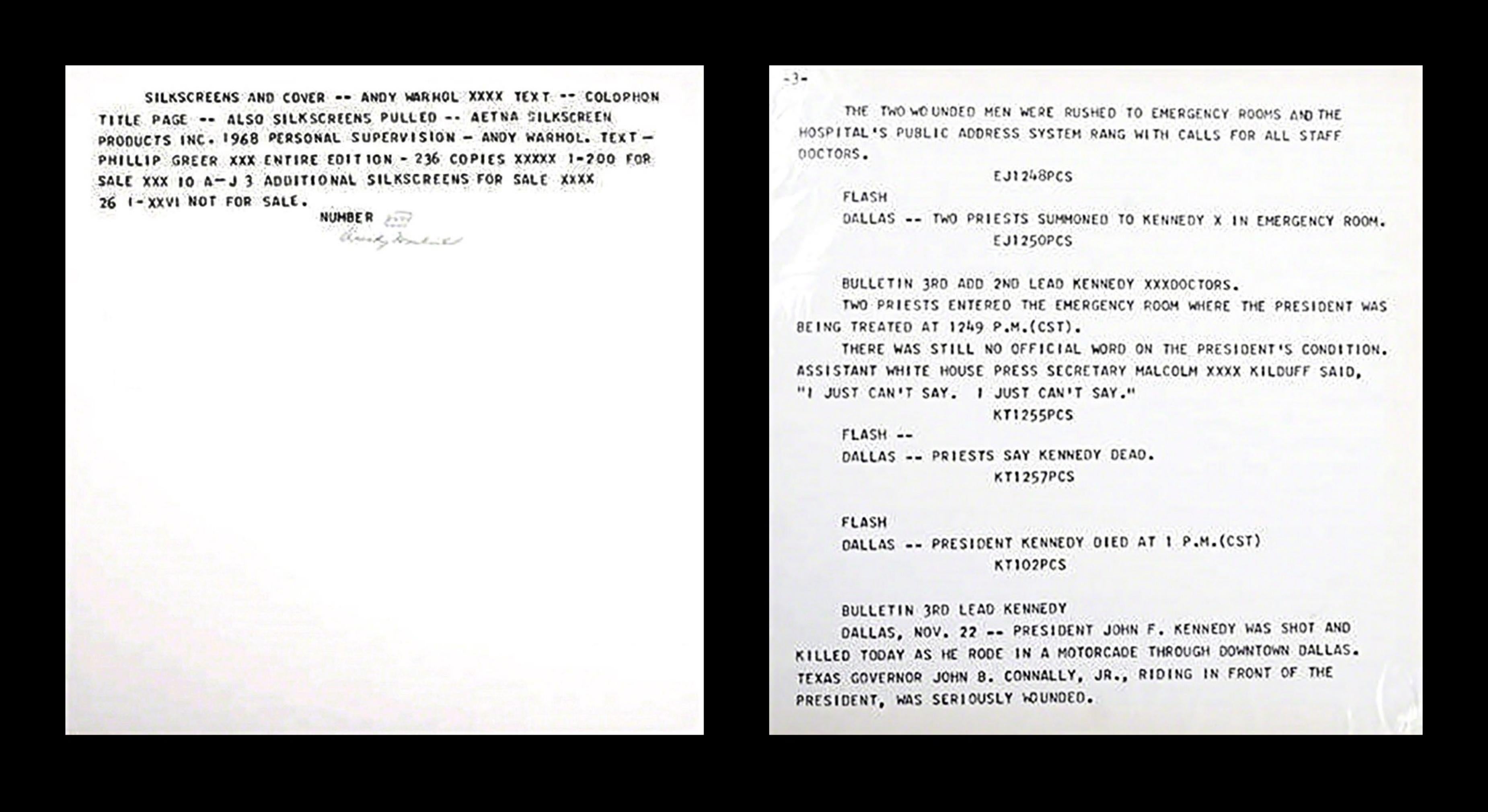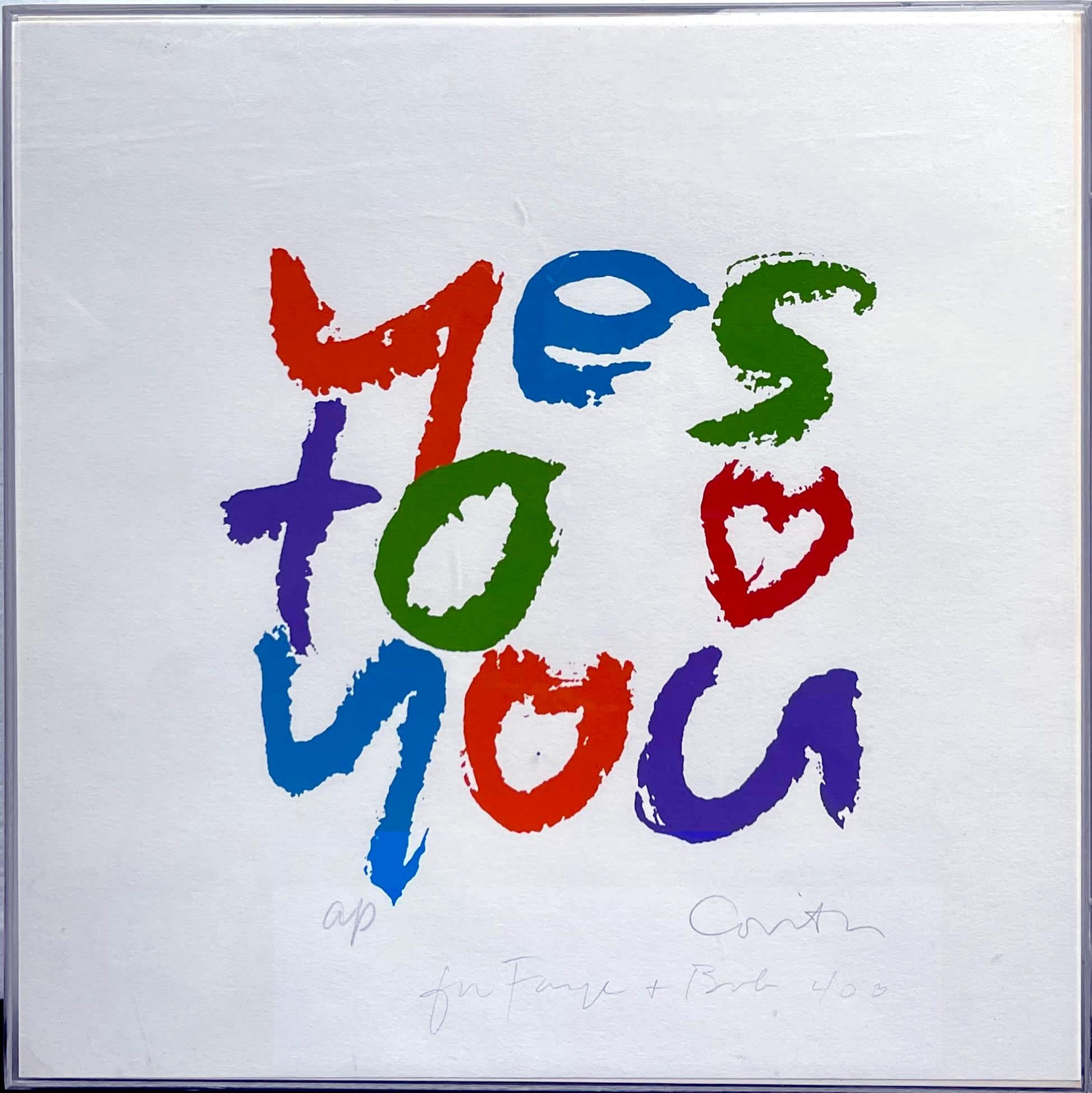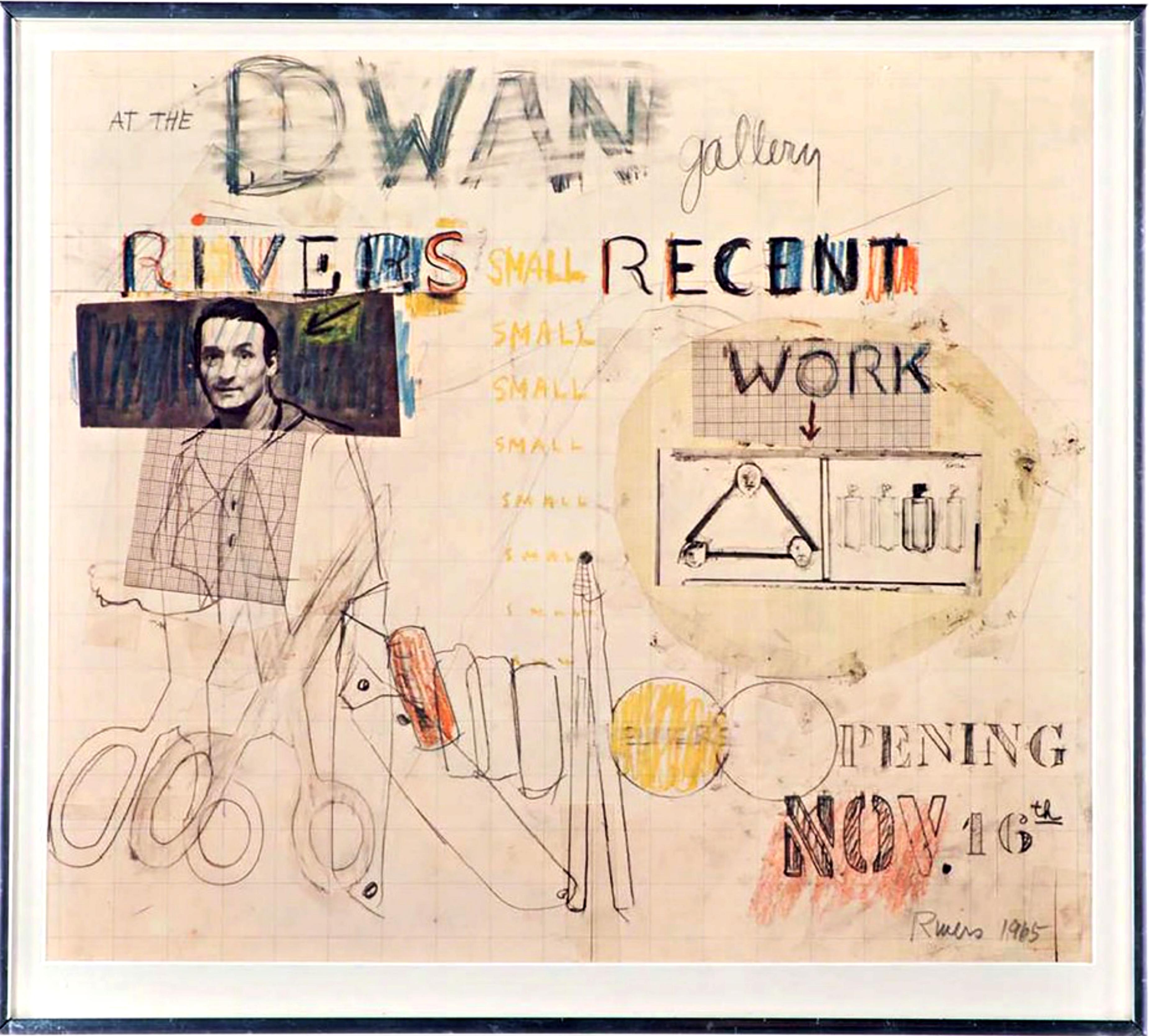Items Similar to Do You Know...?, from the New York Collection for Stockholm portfolio (Signed/N)
Want more images or videos?
Request additional images or videos from the seller
1 of 10
Nam June PaikDo You Know...?, from the New York Collection for Stockholm portfolio (Signed/N)1973
1973
About the Item
Nam June Paik
Do You Know...?, from the New York Collection for Stockholm portfolio, 1973
Silkscreen on paper, in original portfolio sleeve
Signed and dated '73 and numbered 36/300 in graphite pencil recto. text verso: "Copyright 1973 by Nam June Paik Printed at Styria Studios"
12 × 9 inches
Unframed; held in original stamped portfolio sleeve
Pencil signed and numbered 36/300; held in original portfolio sleeve with Crane's Bond #1 paper and artist's name stamped on the outside (see photograph).
Rarely to market, this classic Nam June Paik screenprint on rag paper, was created in 1973 for the legendary "New York for Stockholm" portfolio. Other editions of this print are in the permanent collections of many major museums and public institutions worldwide, which is why they're not often to market, including the Metropolitan Museum of Art, the Museum of Modern Art, the Smithsonian American Art Museum, Moderna Museet, the Walker Art Center, the Los Angeles County Museum of Art, the Dayton Art Institute, the Frost Art Museum,the Herbert F. Johnson Museum of Art, the San Diego Museum of Art, the Princeton University Art Museum, the Pierpoint Morgan Library, and the Albertina Museum, the Kempner Art Museum - to name only a few.
Many works from this portfolio are already in the permanent collections of most major museums and public institutions worldwide.
Held in original portfolio sleeve (see photos)
Publisher:
Experiments in Art & Technology, publisher; Styria Studio printer
- Creator:Nam June Paik (1932 - 2006, American, Korean)
- Creation Year:1973
- Dimensions:Height: 12 in (30.48 cm)Width: 9 in (22.86 cm)
- Medium:
- Movement & Style:
- Period:
- Condition:Very good condition; held in original portfolio sleeve.
- Gallery Location:New York, NY
- Reference Number:1stDibs: LU1745212966592
About the Seller
5.0
Platinum Seller
These expertly vetted sellers are 1stDibs' most experienced sellers and are rated highest by our customers.
Established in 2007
1stDibs seller since 2022
292 sales on 1stDibs
Typical response time: 1 hour
- ShippingRetrieving quote...Ships From: New York, NY
- Return PolicyA return for this item may be initiated within 1 day of delivery.
More From This SellerView All
- Rainbow Signed 1970s silkscreen & lithograph by pioneering female Fluxus artistBy Mary BauermeisterLocated in New York, NYMary Bauermeister Rainbow, 1973 Lithograph and silkscreen on creamy white paper Hand signed, dated and numbered 56/250 by the artist on the front 19 x 25.5 inches Unframed This work is on the permanent collection of various institutions like: Rice University, Samuel Dorksy Museum of Art, Rutgers Zimmerli Museum and Wheaton College Massachusetts. While studying the fringe sciences the 1970s, Bauermeister created Rainbow (1973), a lithograph and silkscreen. She uses a creamy white background as the base. Two intersecting diagonal bands of color transcend across the page, and black cursive lettering dances over the surface serving as a mind map of interweaving ideas. Through the central band, Bauermeister shifts through the color spectrum; she begins with red and finishes with violet. Inspired by music, she uses strokes of color that are rhythmically smeared across the lithograph. The surface lettering, a kind of visual poetry, explores her interest in human emotion and science. The viewer can see Bauermeister’s thoughts as they flow into one another through the use of words such as bliss, love, and healing. Bauermeister also includes a repetition of words such as cancer, sickness, and cure. The word cancer emerges from a cell-like shape. A careful study of the words shows that they may seem dark in nature; however, she juxtaposes these words against the cheerful title and colors. Perhaps the rainbow symbolizes a new hope, an inspiration for an optimistic future. -Courtesy to the Samuel Dorsky Museum of Art About Mary Bauermeister: A multidisciplinary artist known for her intricate and enigmatic assemblages, Mary Bauermeister (1934-2023) continues to defy categorization with layered works in a range of media. A precursory figure of the Fluxus movement—her studio was the meeting point for a number of defining artists of the avant-garde—her work plays an integral role in the discussion of art, both European and American, that emerged from the 1960s. Her reliefs and sculptures, which have incorporated drawing, text, found objects, natural materials and fabric, reference a plethora of concepts: from natural phenomena and astronomy to mathematics and language, as well as her own “spiritual-metaphysical experiences.” Maturing amidst the currents of Minimalism and Pop Art, Bauermeister’s art has resisted labels due to the singular expression of her interests and concerns, among them the simultaneous transience and permanence of the natural world with experimentations in transparency and magnification, multiplication and variation, structure and order, chance and ephemerality, introversion and extroversion. Her three-dimensional receptacles of thoughts, ideas, and notes contain visual, conceptual, and philosophical paradoxes that challenge perceptions and that offer literal and metaphorical windows into which one can glimpse the inner workings of the artist’s mind. - Courtesy of Michael Rosenfeld...Category
1970s Modern Abstract Prints
MaterialsLithograph, Screen, Mixed Media, Pencil, Graphite
- My Love We Wont - coveted, whimsical 1960s silkscreen by beloved female artistBy Niki de Saint PhalleLocated in New York, NYNiki de Saint Phalle My Love We Wont, 1968 Lithograph and silkscreen on wove paper Signed and numbered 51/75 in graphite pencil on the front Frame included: elegantly floated and framed in a museum quality white wood frame with UV plexiglass From the Brooklyn Museum, which has an edition of this work in its permanent collection: "Throughout her long and prolific career Niki de Saint Phalle, a former cover model for Life magazine and French Vogue, investigated feminine archetypes and women’s societal roles. Her Nanas, bold, sexy sculptures...Category
1960s Modern Abstract Prints
MaterialsScreen, Mixed Media, Lithograph, Pencil
- The Golden Future of America (Sheehan, 92)By Robert IndianaLocated in New York, NYRobert Indiana The Golden Future of America (Sheehan, 92), 1976 Silkscreen on Arches paper Signed and dated in pencil, lower right; numbered 13/175, in pencil, lower left. Also bears printers blind stamp Frame included: Elegantly matted and framed in a handmade wood frame On its face, this Robert Indiana's silkscreen, based upon the eponymous painting "The Golden Future of America", is a patriotic celebration of Americana, done for the country's bicentennial year. But its looks are deceptive, as the work has a far more subversive meaning. In 2014, the Art Newspaper...Category
1970s Pop Art Abstract Prints
MaterialsScreen, Pencil
- Flash portfolio colophon page, JFK Assassination (Hand signed)By Andy WarholLocated in New York, NYAndy Warhol Flash portfolio colophon pages, JFK Assassination, 1968 2 Separate Silkscreens: (1) Silkscreen text on paper and teletype text; (2) colophon sheet in pencil and numbered XVII (from the edition of 26 (roman numerals) Hand-signed by artist, two silkscreen prints; the colophon sheet is hand signed by Andy Warhol; no signature on sheet with teletype 21 1/2 × 21 1/2 inches Unframed Note: measurements are for each sheet Catalogue Raisonne Reference: FS II.32-42 (not illustrated) Silkscreened colophon sheet of the edition XVII of the iconic "Flash" Portfolio; hand signed and uniquely numbered by Andy Warhol, plus silkscreened print with teletype text. These two prints from Warhol's iconic "Flash Portfolio" were selected for inclusion in the blockbuster Andy Warhol retrospective at the Whitney Museum in 2019. (see photos). The plaque on the Whitney exhibition (also see included photo) describes the portfolio as follows:" These screenprints reflect Warhol's ongoing interest in the Kennedy assassination, an obsession that intensified following the release of the Warren Commission report and the publication of stills from a short home movie of the event, published by bystander Abraham Zapruder. Flash - November 22, 1963 is an unbound Artists Book with text based upon the original Associated Press newswire bulletins. For his illustrations, Warhol appropriated the recurring image of Kennedy from a 1960 campaign poster, and sourced the remaining photographs, including pictures of Lee Harvey Oswald and an ad for the type of rifle used, from Life's [Magazine] sustained coverage of the assassination and its aftermath.." The present sheet begins with the following teletyped text: "THE TWO WOUNDED MEN WERE RUSHED TO EMERGENCY ROOMS, AND THE HOSPITAL'S PUBLIC ADDRESS SYSTEM RANG WITH CALLS FOR ALL STAFF DOCTORS. FLASH DALLAS - TWO PRIESTS SUMMONED TO KENNEDY X IN EMERGENCY ROOM BULLETIN 3RD ADD 2ND LEAD KENNEDY XX DOCTORS TWO PRIESTS ENTERED THE EMERGENCY ROOM WHERE THE PRESIDENT WAS BEING TREATED AT 12:49 P.M. (CST). THERE WAS STILL NO OFFICIAL WORD ON THE PRESIDENT'S CONDITION. ASSISTANT WHITE HOUSE PRESS SECRETARY MALCOLM XXX KILDUFF SAID "I JUST CAN'T SAY. I JUST CAN'T SAY." FLASH -- PRIESTS SAY KENNEDY DEAD. .""" (the text on the page continues; this is just a partial excerpt.) Racolin Press, Briarcliff Manor, New York Two Andy Warhol silkscreens on white wove paper comprising the signed colophon and text pages of his iconic 1968 "Flash" Portfolio, as well as Warhol's wraparound silkscreen of the distinctive teletype text. The colophon page silkscreen is hand signed by Andy Warhol and uniquely numbered XVII in pencil from the edition of 26, which, it expressly states, was not for sale. The second silkscreen sheet features teletype print describing events surrounding the assassination of President John F. Kennedy - the defining event of a generation as contemporaneously re-imagined by the most important Pop artist of the era. Warhol created the "Flash - November 22, 1963" portfolio of prints in 1968 to depict the continuing media spectacle surrounding JFK's assassination. He named the portfolio after the news flash Teletype texts that reported the assassination and its aftermath - the first major news event played out live on TV. The Flash portfolio includes a series of eleven silkscreens depicting President Kennedy smiling broadly, a presidential seal with bullet holes through it, and other symbolic representations of that tragedy. The portfolio's cover includes an image of the New York World-Telegram front page with the headline "President Shot Dead." Warhol used screen printed...Category
1960s Pop Art Abstract Prints
MaterialsScreen, Pencil
- Yes to You, silkscreen, pencil signed Artists Proof with heart (regular ed. 200)By Corita KentLocated in New York, NYCorita Kent Yes to You, 1979 Color silkscreen Hand signed, numbered and uniquely inscribed with a heart doodle by the artist on the front. Artists Proof (aside from the regular editi...Category
1970s Pop Art Abstract Prints
MaterialsScreen, Pencil
- At The Dwan Gallery: Historic exhibition poster (Hand Signed by Larry Rivers)By Larry RiversLocated in New York, NYLarry Rivers At The Dwan Gallery: Rivers Small Recent Work (Hand Signed), 1965 Silkscreen on wove paper Hand signed and dated "Rivers, 1965" in graphite pencil lower right front Fram...Category
1960s Pop Art Abstract Prints
MaterialsScreen, Pencil
You May Also Like
- Geometric Woman's Portrait - Rare Signed Graphite Drawing on Paper 1962Located in Soquel, CAGeometric Woman's Portrait - Rare Signed Graphite Drawing on Paper 1962 Beautiful, soft original drawing by Eugene Hawkins (American, b. 1933). A realistic depiction of a short-haired woman, her large lips parted into a soft smile. She's surrounded in geometric shapes offering a wonderful juxtaposition to the natural curves of her face and hair. Signed in pencil, "Eugene Hawkins '62" Presented in a new black mat. Mat size: 20"H x 16"W Paper size: 18.5"H x 14.5"W Eugene Hawkins (American, b. 1933) is a BIPOC artist known for his detailed portraiture and printmaking. He is listed in Who Was Who in American Art, 1564-1975, and his work was exhibited in the Whitney Museum of American Art. He spent the majority of his life working and exhibiting in Southern California. His work frequently touches upon socio-political subjects, making strong statements about the world. The California African American Museum features Eugene Hawkins's work in the Permanent Collection. Exhibition: 2017 Paperworks: Selections from the Permanent Collection focuses on works on paper produced from 1950-2000 and includes figurative, impressionistic, and abstract styles. The exhibition showcases the radically diverse range of works on paper created by African American and other artists over the last two centuries, and includes drawings, prints, paintings, and collages by Edward Mitchell Bannister...Category
1960s American Modern Figurative Prints
MaterialsGraphite, Paper
- El Herido, 1960's Spanish Avant Garde Political Screenprint Lithograph SignedBy Rafael CanogarLocated in Surfside, FLThe Wounded One (El Herido) from Violence (La Violencia) 1969 signed, dated and titled in pencil Dimensions: sheet: 22 1/16 x 30 1/16" (56 x 76.4cm) Rafael Canogar ( Toledo , 1935) is a Spanish painter, one of the leading representatives of abstract art in Spain. Disciple of Daniel Vazquez Díaz (1948-1953), in his first works he found a way to reach the avant garde and, very soon, to study abstraction deeply. He initially used a sculpture technique: with his hands he scratched or squeezed the paste that vibrated on flat colored backgrounds. It was a painting in which the initial gesture comes directly from the heart. At this point, Canogar embodied the best of painting material . In 1957 he founded with other artists the EI Paso group. With artists like Luis Feito, Manolo Millares, Pablo Serrano, Manuel Rivera and Antonio Saura, he begins the Spanish avant-garde movement and continues to do so until 1960. It is influenced by Action painting. They defended, between 1957 and 1960 , an informal aesthetic and the opening of Franco Spain...Category
1960s Modern Abstract Prints
MaterialsScreen
- The Boundaries Of Our Realities Are Set By The Limits Of Our ImaginationBy The Connor BrothersLocated in New York, NYA pristine color screenprint, acrylic and oil paint and varnish over giclée on paper. Signed and dated in white ink by the Connor Brothers. Dimensions with the frame are 32 x 22 inches.Category
2010s Modern Figurative Prints
MaterialsPaper, Varnish, Oil, Acrylic, Color, Giclée, Screen
- (Partial) Portfolio containing 3 (three) lithographs and etchingsBy GraficaLocated in Kansas City, MOGrafica '68 (Partial) Portfolio containing 3 (three) lithographs and etchings Originally issued with 10 Lithographs, Silk Screens and Etchings, of which 7 (seven) are missing Year: 1968 Edition: 100 Size: 17.6 x 23.6 in. or 23.6 x 17.6 in. Publisher: Il Torcoliere, Rome - Italy Signatures: Sheets signed and numbered by hand Comes with folio box and individual artists' presentation sheets. --------------------------------- Artists works included: RENZO VESPIGNANI "Report on the artist" Year: 1968 Medium: Lithograph in two colors Edition: 100 Size: 17.6 x 23.6 in. Publisher: Il Torcoliere, Rome - Italy Signed and numbered Ref: RVE_1909_01 LUCIANO DE VITA "Le cavalier inconnu" Year: 1968 Medium: Etching Edition: 100 Size: 23.6 x 17.6 in. Publisher: Il Torcoliere, Rome - Italy Signed and numbered Ref: LDV_1909_01 PIERO GUCCIONE "Images" Year: 1968 Medium: Lithograph in four colors Edition: 100 Size: 23.6 x 17.6 in. Publisher: Il Torcoliere, Rome - Italy Signed and numbered Ref: PGU_1909_01 ======================= Renzo Vespignani was an Italian painter, printmaker and illustrator. Vespignani illustrated the works of Boccaccio, Kafka and T. S. Eliot, among others. In 1956, he co-founded the magazine Citta Aperta and in 1963, co-founded the group II Pro e II Contro for neorealism in figure art. ---------------- Luciano De Vita ( Ancona , 1929 - 1992 ) was an Italian painter , engraver , set designer and lecturer . Born in Ancona, De vita arrived in Bologna in the first post-war period, after having actively participated in the Second World War and having suffered the dramatic consequences. He attended the Academy of Fine Arts and was a pupil of Giorgio Morandi. From 1962 he taught in Milan at the Brera Academy , while in 1975 he returned to Bologna where he obtained the same chair of engraving that had been Morandi's from 1930 to 1956 . De Vita also actively dedicated himself to the theater , overseeing sets and costumes for shows that were also staged at La Scala in Milan. An example is the Turandot curated by Raoul Grassilli. ---------------- Emilio Vedova (9 August 1919 – 25 October 2006) was a modern Italian painter...Category
1960s Modern Figurative Prints
MaterialsEtching, Lithograph, Screen
- Study/Falling Man (Series I)By Ernest Tino TrovaLocated in Missouri, MOStudy/Falling Man (Series I), 1967 By. Ernest Tino Trova (American, 1927-2009) 24 x 24 inches Wrapped on Foam Core Signed Artist Proof Lower Right Ernest Tino Trova (American, 1927-...Category
1960s American Modern Abstract Prints
MaterialsScreen
- Trova/Index, WavesBy Ernest Tino TrovaLocated in Missouri, MOTrova/Index, Waves, 1969 By. Ernest Tino Trova (American, 1927-2009) Signed in Pencil Lower Right Unframed: 10.5 x 7.5 inches With Frame: 15.25 x 11.75 inches Known for his Falling ...Category
20th Century American Modern Abstract Prints
MaterialsScreen
Recently Viewed
View AllMore Ways To Browse
Tiffany In Palm Desert
Tiffany Palm Desert
Us 1012
Chinese Peasant Art
Durer Jerome
Dutch Hearts Jim Dine
Horst Janssen
Loch Earn
Madame Butterfly Poster
Renoir Maternite
Roy Lichtenstein Crak
Salvador Dali Last Supper
Saturn Messenger
Surrealist Piano Salvador Dali
Tiffany And Co Holiday China
1931 Rolex
Alberto Salietti On Sale
Art Print Rowena
